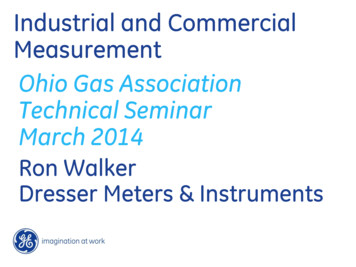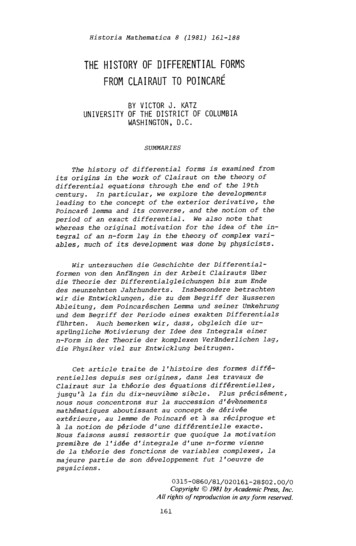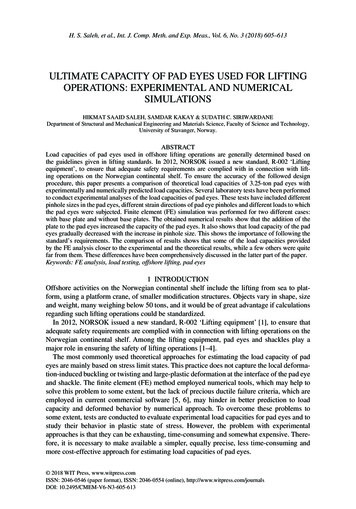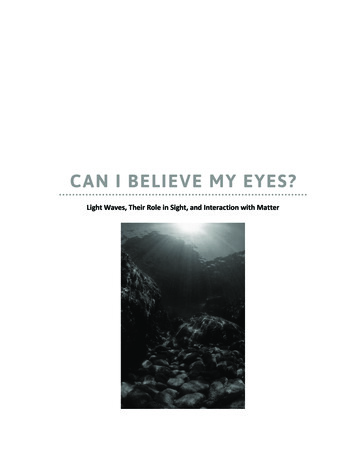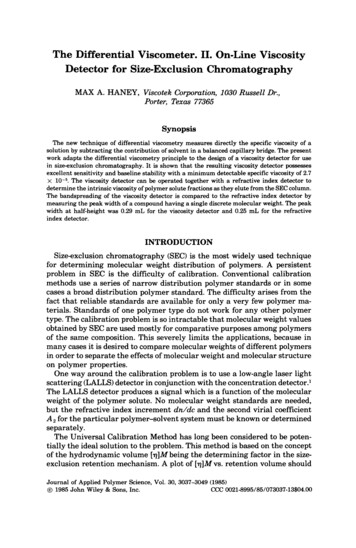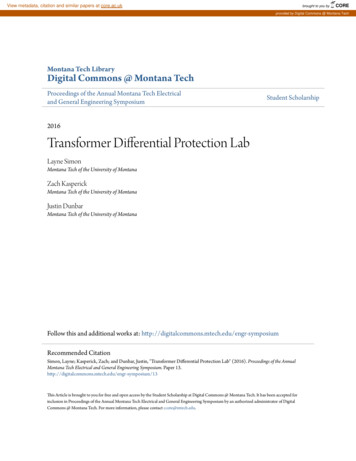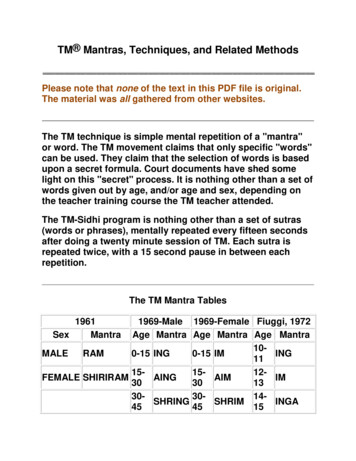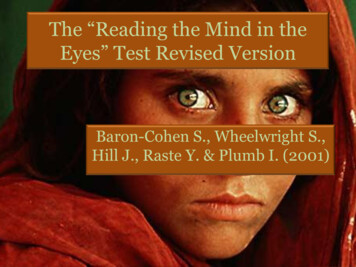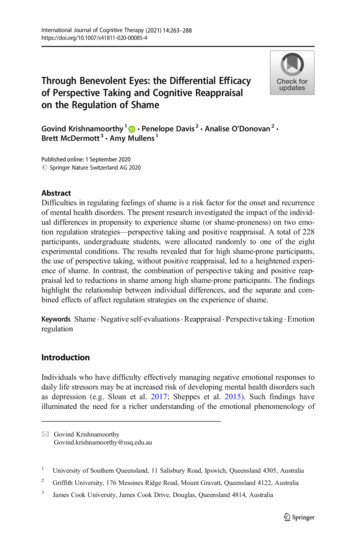
Transcription
International Journal of Cognitive Therapy (2021) 85-4Through Benevolent Eyes: the Differential Efficacyof Perspective Taking and Cognitive Reappraisalon the Regulation of ShameGovind Krishnamoorthy 1 & Penelope Davis 2 & Analise O’Donovan 2 &Brett McDermott 3 & Amy Mullens 1Published online: 1 September 2020# Springer Nature Switzerland AG 2020AbstractDifficulties in regulating feelings of shame is a risk factor for the onset and recurrenceof mental health disorders. The present research investigated the impact of the individual differences in propensity to experience shame (or shame-proneness) on two emotion regulation strategies—perspective taking and positive reappraisal. A total of 228participants, undergraduate students, were allocated randomly to one of the eightexperimental conditions. The results revealed that for high shame-prone participants,the use of perspective taking, without positive reappraisal, led to a heightened experience of shame. In contrast, the combination of perspective taking and positive reappraisal led to reductions in shame among high shame-prone participants. The findingshighlight the relationship between individual differences, and the separate and combined effects of affect regulation strategies on the experience of shame.Keywords Shame . Negative self-evaluations . Reappraisal . Perspective taking . EmotionregulationIntroductionIndividuals who have difficulty effectively managing negative emotional responses todaily life stressors may be at increased risk of developing mental health disorders suchas depression (e.g. Sloan et al. 2017; Sheppes et al. 2015). Such findings haveilluminated the need for a richer understanding of the emotional phenomenology of* Govind versity of Southern Queensland, 11 Salisbury Road, Ipswich, Queensland 4305, Australia2Griffith University, 176 Messines Ridge Road, Mount Gravatt, Queensland 4122, Australia3James Cook University, James Cook Drive, Douglas, Queensland 4814, Australia
264International Journal of Cognitive Therapy (2021) 14:263–288mental health conditions and investigations of the role of specific emotions. Oneemotion that has been the subject of extensive research is shame. Shame is commonlydefined as an intense negative emotion characterized by the perception of a globaldevaluation of the self (Tangney and Dearing 2003). Shame has been conceptualized asbeing fundamentally different from other emotions, such as guilt, as it results fromattributing information about a specific situation to characterological defects (e.g. aperson feeling ashamed may think, ‘I am bad’) rather than to situational factors (e.g. aperson feeling guilty may think, ‘I did something bad’) (Lewis 1987, p. 42).The inability to regulate feelings of shame is a significant risk factor for the onsetand recurrence of depression (Kim et al. 2011), anxiety (Fergus et al. 2010), suicide(Wiklander et al. 2012), post-traumatic stress disorder (Cunningham et al. 2019),addictions (Potter-Efron and Bruce 2014), eating disorders (Duarte and PintoGouveia 2017), personality disorders (Peters & Geiger, 2016) and violent behaviour(Shanahan et al. 2011). With evidence on the role of shame in psychopathologyaccumulating, new research is focusing on ways individuals may more effectivelyregulate shame. Studies on the emotion regulation of shame have focused on those whoare ‘shame-prone’—individuals who experience shame on a frequent basis (Whittleet al. 2016; Stuewig et al. 2015; Tangney and Dearing 2003). ‘Shame-proneness’ hasbeen conceptualized as a dispositional trait (as opposed to an experience or state) andshame has been shown to be a pervasive aspect of the identities of shame-proneindividuals (Tangney and Dearing 2003). Theories on the links between shame andpsychopathology have focused on the ways in which the emotion regulation strategiesof perspective taking and positive reappraisal have mitigated the effects of shame(Webb et al. 2012).Perspective TakingPerspective taking, also referred to in the literature as self-distancing1, is an emotionregulation strategy wherein individuals adopt an external perspective and thus ‘thinkabout themselves as an object of attention’ (Kross and Ayduk 2017). Recalling andthinking about experiences of anger and sadness from a third-person perspective hasbeen found to lead to a attenuation of negative emotions, compared to taking a firstperson perspective, which often leads to more ruminative styles of thinking (Kross andAyduk 2008; Kross, Ayduk & Mischel, 2005). For example, in a series of experimentalstudies, Libby et al. (2005) manipulated the memory perspective (first-person vs. thirdperson) that individuals used to visually recall autobiographical events and examinedits effects on assessments of personal change in psychotherapy. The results revealedthat participants told to recall their first appointment from the third-person perspectivethought they had changed more than those told to recall the event from the first-personperceptive. Thus, the authors concluded that recalling significant autobiographicalevents from different visual perspectives led to different judgements over time. In theirmeta-analysis, Webb et al. (2012) identified perspective taking as one of the mosteffective techniques for facilitating emotion regulation.1Given the current public health recommendations around physical distancing in light of COVID-19, the term‘perspective taking’ has been used over ‘self-distancing’ to avoid confusion.
International Journal of Cognitive Therapy (2021) 14:263–288265Such findings are consistent with work on mindfulness and meditation (Brown andRyan 2003; Kabat-Zinn et al. 1992) and perspective taking is reflected in therapeuticapproaches that encourage people to consider negative feelings and experiences fromdiverse perspectives (Linehan 1993; Teasdale et al. 2000). While much research pointsto the benefits of such perspective taking, several theorists have argued that perspectivetaking on its own may not have the same benefits in regulating shame as when coupledwith positive reappraisal (e.g. Robinson and Swanson 1993).Positive ReappraisalPositive reappraisal, also referred to as cognitive reappraisal, is another cognitivecoping strategy in which negative life events are actively recast in a more positivelight (e.g. Lazarus and Folkman 1984; Gross, 1998). Thinking about the ‘good that cancome from a stressful event’ is consistent with notion of positive reappraisal asinvolving a positive interpretation of a situation, or ‘finding the silver lining’ (Levineet al. 2012). Positive reappraisal has been found to be effective for regulating affect andphysiological arousal without the costs, such as increased negative affect, associatedwith other strategies such as rumination (Gross, 1998). Positive reappraisal also haslonger-lasting effects than attention-focused strategies (e.g. distraction) (Ochsner et al.2012; Silvers et al. 2015) and is a core component of several therapeutic modalities,including cognitive behavioural therapy (Beck 2005). A number of studies have foundpositive reappraisal to be beneficial for both mental and physical health outcomes(Penley et al. 2002).The ability to positively reappraise may be particularly salient for regulation ofshame, as the experience of shame is often linked to ruminative cognitions withinternal, stable, and uncontrollable attributions (e.g. thinking ‘I’m dumb’ in responseto failure) (Tracy et al. 2007). In particular, this cognitive style has been linked toshame-proneness and has been found to be independently associated with depression,beyond the effects of a depressogenic attributional style (Tangney et al. 1992). Although no studies identified to date have assessed the impact of shame-proneness onpositive reappraisal, several studies have found that experimentally induced positivereappraisal leads to a reduction in reports of negative emotions in both clinical and nonclinical samples (e.g. Ehring et al. 2010; Rood et al. 2012). However, some studieshave found that individuals scoring high on indicators of neuroticism (Jylhä &Isometsä, 2006)—characterized by proneness to anxiety, emotional instability andself-consciousness—have difficulty reappraising negative emotions.Similarly, individuals identified as having a self-critical cognitive style—similar tothose who are highly shame-prone—are seen as being less responsive to cognitiveinterventions (e.g. Castilho et al. 2017). Such research highlights that those who areshame prone have difficulty with using and benefiting from positive reappraisal. Thefindings also raise concerns about whether the efficacy of such cognitive interventioncan be enhanced by the combined use of shame mitigation strategies. Interventionsaimed at promoting the benefits of perspective taking while preventing self-criticalcognition—particularly among shame-prone individuals—have led to the developmentof therapeutic techniques such as self-compassion (Neff 2003; Gilbert, 2010). Whileseveral studies on such practices have reported beneficial effects for shame-proneindividuals (e.g. Woods and Proeve 2014; Mosewich et al. 2011), few experimental
266International Journal of Cognitive Therapy (2021) 14:263–288studies to date have investigated the unique contributions of positive reappraisal andperspective taking to attenuation of shame in such interventions.Katzir and Eyal (2013) evaluated the efficacy of perspective taking and positivereappraisal on the experience of shame and other emotions (e.g. guilt, anger andsadness). Two hundred forty-eight university students completed the experiment individually, guided by pre-recorded audio instructions adapted from Kross et al. (2005). Itwas predicted that due to the experience of shame involving self-evaluation as well asthe evaluation of the self from the perspective of others, a third-person perspective mayexacerbate these emotions and fail to attenuate the experience of shame. The resultsrevealed that while a third-person perspective attenuated feelings of sadness and anger,such benefits were not replicated for feelings of shame. In particular, Katzir and Eyal(2013) found that participants who adopted the perspective of a third-person, neutralobserver when thinking about a shameful event failed to experience any attenuation intheir experience of shame. They argued that perspective taking not accompanied bypositive reappraisal leads to an increase in self-critical evaluations and rumination onothers’ negative evaluations of them (Katzir and Eyal 2013). Katzir and Eyal’s (2013)study is significant as it illustrates the differential efficacy of perspective taking on theregulation of self-conscious emotions like shame, compared to other emotions like fear.The study also highlights the need for a further understanding of the individualdifferences that influence the combined and separate effects of these emotion regulationstrategies on shame.In summary, evidence suggests that shame plays a unique role in the developmentand maintenance of psychopathology. Despite the burgeoning literature on the efficacyof various emotion regulation strategies on negative affect, there have been limitedinvestigations to date into the specific effects of these strategies on shame. Namely,there appears to be a paucity of studies regarding efficacious strategies for individualswho are prone to experiencing shame and may therefore be more vulnerable todeveloping various forms of psychopathology. Thus, the present study aims to extendKatzir and Eyal’s (2013) research by evaluating the specific and combined effects oftwo promising emotion regulation strategies, positive reappraisal and perspectivetaking, on the regulation of feelings of shame experienced by individuals differing inshame-proneness.The Present StudyThis experimental study was designed to examine how different forms of positivereappraisal and perspective taking influence the regulation of shame following a moodinduction task that involves recalling a shameful autobiographical event. To understandwhether the effects of the emotion regulation strategies are specific to shame, theinfluence of these strategies on other negative emotions (anger, anxiety, sadness, guiltand disgust) and positive emotions (happiness, pride, hope, amusement and affection)were also measured.Based on previous experimental research, we developed the following hypotheses.Hypothesis 1: Participants instructed to engage in positive reappraisal of anautobiographical event in which they felt shame (condition: positive reappraisal)report lower levels of shame compared to participants instructed to focus on
International Journal of Cognitive Therapy (2021) 14:263–288267aspects of the event that initially made them feel and respond negatively (notencouraged to reframe the event positively; condition: no positive reappraisal).Hypothesis 2: Among low shame-prone participants, those instructed to adopt athird-person perspective report lower levels of shame compared to participantsasked to adopt a first-person perspective (i.e. low shame-prone participants willbenefit from the purported benefits of a third-person perspective).Hypothesis 3: Low shame-prone participants asked to adopt a third-person perspective, together with positive reappraisal, report the lowest levels of shame.Hypothesis 4: Among high shame-prone participants, those instructed to adopt athird-person perspective report the same levels of shame as participants asked toadopt a first-person perspective (i.e. high shame-prone participants do not benefitfrom taking a third-person perspective).Hypothesis 5: Participants with a high propensity to experience shame (highshame-prone) report higher levels of shame compared to participants with a lowpropensity to experience shame (low shame-prone) when recalling an autobiographical, shame-eliciting event, irrespective of the memory perspective adoptedor the use of positive reappraisal.Together these hypotheses lead to the prediction of a three-way interaction betweenshame-proneness, positive reappraisal and perspective taking in the manipulation phaseof the study. These variables may also interact in other ways to influence the outcome.However, no compelling theoretical or empirical grounds exist for the ad hoc predictionof additional interactions and no firm predictions were made concerning them.MethodWe report how we determined the sample size, all manipulations, all exclusions and allmeasures in the study. Ethics approval to conduct the study was received from theGriffith University Human Research Ethics Committee (Reference Number: PSY/03/08/HREC). This research did not receive any specific grant from funding agencies inthe public, commercial or not-for-profit sectors. On behalf of all authors, the corresponding author states that there is no conflict of interest.ParticipantsStudy participants were 228 undergraduate students (46 males, 182 females) ranging inage from 16 to 51 years (mean age 20.99 years, SD 6.37 years). Consistent with otherexperimental studies investigating the impact of positive reappraisal (Ray et al. 2008)and perspective taking (Libby & Eibach, 2002) in non-clinical populations, the aim wasto recruit 20 participants in each of the eight experimental conditions, with a minimumof 10 per condition. This sample size was determined in order to detect effect sizes ofd .20 with statistical power equal to 0.80 at significance level 0.05. Participants werefrom Griffith University in Australia and were recruited via an advertisement on theuniversity’s research participation website. The online advertisement described thestudy as an investigation into individual differences in the recall of emotional events.
268International Journal of Cognitive Therapy (2021) 14:263–288All participants were introductory psychology students who were given credit towardtheir course grade.MeasuresShame-proneness: Test of Self-Conscious Affect-3 (TOSCA-3) The Test of SelfConscious Affect (TOSCA; Tangney, et al., 1989) measures proneness to shame andguilt and has been used extensively in studies of shame (e.g. Ferguson & Crowley,1997; Quiles & Bybee, 1997). The TOSCA is a scenario-based measure in which 15common situations are posed to respondents, followed by descriptions of shame, guiltand other emotional (e.g. alpha and beta pride) and defensive (e.g. externalization anddetachment) responses to the situation, without use of emotion labels. The TOSCA hasdemonstrated good internal consistency for shame-proneness and guilt-proneness(Cronbach’s α .76 and .66, respectively; Tangney, 1990, 1991; Tangney et al.,1996). In our sample, internal consistency for TOSCA was satisfactory withCronbach’s α 0.74. Participants were divided into groups of ‘high shame-proneness’and ‘low shame-proneness’ based on a median split of shame-proneness scores—with12 participants with median shame-proneness scores excluded from the groups.Affective states: visual analogue scales (VAS) Participants were asked to rate the extentto which they experienced 11 emotions (anger, happiness, anxiety, pride, sadness,shame, hope, guilt, amusement, disgust and affection) during the six experimentalphases on a Likert rating scale from 1 (not at all) to 10 (extremely).ProcedureThe study adapted Katzir and Eyal’s (2013) experimental method to investigateparticipants’ experiences of shame. Figure 1 depicts the experimental phases of thestudy. The eight groups correspond to combinations of the two forms of perspectivetaking (first-person perspective, third-person perspective; ‘Perspective’ hereafter), thetwo positive reappraisal styles (positive reappraisal, no positive reappraisal; ‘Appraisal’hereafter) and the two levels of shame-proneness (high shame-proneness, low shameproneness; ‘Shame-proneness’ hereafter).In the baseline phase, participants were asked to rate their current affective state withthe visual analogue scales (VAS) with respect to 11 emotions (anger, happiness,anxiety, pride, sadness, shame, hope, guilt, amusement, disgust and affection) (Fig.1). In the second phase, mood induction, participants were asked to identify a recent,unresolved event that had generated feelings of shame. The participants were providedwith brief descriptions of typical shame-inducing events and emotional reactions toshame-inducing events to help them recall shame events. When an experience came tomind, the participants were asked to write down a detailed description of the memory inthe response booklet provided (phase: free recall (shame event); Fig. 1). The participants were given 5 min to recall and describe the memory.Participants then rated the emotions they experienced both during (or soon after) theshame event and in the present, when they recalled the experience at the present time.They were also asked how long ago the event occurred and to rate the extent to which
International Journal of Cognitive Therapy (2021) 14:263–288269Fig. 1 Flow chart of the experimental phases of the study. Numbers in the parentheses indicate chronologicalsequence of data collectionthey thought about the event both from a first-person perspective and from a thirdperson perspective (Appendix). These ratings were made using a 5-point scale (0 notat all, 4 a lot). Following this, participants were instructed to rest quietly for 2 min(phase: rest period 1; Fig. 1). No other specific instructions were provided to theparticipants during this phase. After the rest period, the participants once again ratedtheir emotions on the 10-point VAS. They were also asked to rate the extent to whichthey had thought about the shame event in the rest period on a scale of 0% (did notthink about the event at all during the rest period) to 100% (thought about the eventduring the entire rest period). If the participants did think about the event, they wereasked to rate the extent to which they thought about it from a first-person perspectiveand from a third-person perspective.Participants were then allocated randomly to one of the eight experimental conditions. In each of the conditions, participants were asked to think about their recalledshame event again. Participants were given specific instructions on aspects of the eventto focus on, depending on the experimental condition they were allocated to (i.e. firstor third-person perspective; positive reappraisal or no positive reappraisal; see Appendix for instructions provided to groups). Instructions relating to positive reappraisal of
270International Journal of Cognitive Therapy (2021) 14:263–288the recalled shame event were adapted from those used by Ray et al. (2008). Instructions relating to perspective-taking were adapted from Libby et al. (2005).Participants were then asked to follow these instructions for 2 min (phase: instructedrecall) (Fig. 1). At the end of this instructed recall task, participants were once againasked to rate their emotions on the VAS. They were also asked to report theircompliance with the instructions by rating the extent to which they thought about theevent from their own perspective and from another person’s perspective, and the totalamount of time during the task they spent thinking about the shame event. Participantswere then given 5 min to answer the five questions posed to them during the instructedrecall task (e.g. Can you see whether you are standing or sitting?) and describe whatand how they thought about the shame event during the instructed recall task.Following this, participants were asked to rest quietly for 2 min (phase: rest period 2)(Fig. 1). They were then once again asked to rate their emotions, the extent to whichthey thought about the shame event during the rest period, and the extent to which theythought about the shame event from their own perspective and from another person’sperspective. Participants were then asked to recall and describe a recent experience offeeling happy for 3 min (phase: free recall (happy event)) (Fig. 1). This phase wasincluded in the study in order to provide participants with an opportunity to recoverfrom the experience of negative emotions and finish the study feeling less distressed.After describing their happy event, participants were asked to rate their emotions on therating scale. Finally, participants were asked to complete the Test of Self-ConsciousAffect (TOSCA).ResultsPreliminary AnalysesA 2 (Appraisal) 2 (Perspective) 2 (Shame-proneness) analysis of variance(ANOVA) conducted on age revealed a main effect for Appraisal, F (1, 206) 5.39,η2 0.02, p 0.05. The means for Appraisal revealed that participants in the positivereappraisal groups (M 22.03, SE 0.63) were significantly older than participants inthe no positive reappraisal groups (M 19.96, SE 0.62). Given this difference,participant age was controlled for in final analyses.A series of 2 (Appraisal) 2 (Perspective) 2 (Shame-proneness) ANOVAs werealso conducted on the various characteristics of the shame event recalled. The meansand standard deviations for attributes of the shame events are presented in Table 1. TheANOVAs revealed no significant group differences for these variables. The averageintensity of shame experienced during the recalled shame event was high (M 7.92,SE 2.08).A significant main effect was found for shame-proneness in rest period 1, F (1,206) 5.22, η2 0.02, p 0.05, and rest period 2, F (1, 206) 6.92, η2 0.03,p 0.01. A comparison of group means revealed that during both rest periods, participants in high shame-proneness groups (MRest Period 1 4.19, SE 0.32; MRest Period 2 4.19, SE 0.35) reported having thought about the shame event more often thanparticipants in low shame-proneness groups (MRest Period 1 3.23, SE 0.26; MRest Period
International Journal of Cognitive Therapy (2021) 14:263–288271Table 1 Means (with standard deviation in parenthesis) for ratings of shame for the eight groups as a Functionof Appraisal, Perspective and Shame-PronenessPhaseConditionNBaselineF r e e r e c a l l R e s t Instructed R e s t F r e e r e c a l l Mean(shame event) period 1 recallperiod 2 (happy event)First-person perspectivePositive .352.31(0.37)(2.35)(1.79)(1.76)(1.61)(0.83)(0.98) 0.96) No positive appraisal Low )(2.02)(1.07)(3.16)(1.49)(0.49)(1.40) High )Third-person perspective Positive appraisal Low )(2.35)(1.27)(1.82)(1.57)(0.70)(0.81) High )(2.83)(2.38)(1.52)(2.54)(1.47)1.41 2)(2.01)(1.05) No positive appraisal Low )(2.47)(1.92)(2.67)(2.04)(0.71)(1.27) High )(2.82)(2.70)(2.52)(2.75)(1.96)(1.93) 3)(2.44)(1.45)Shame-pronenesswas ascertained using participant scores on the Test of Self-Conscious Affect (TOSCA) (Tangney et al.,1989). Ratings of affective states were obtained using a 10-point visual analogue scale (VAS) Likert ratingscale. Twelve participants with median shame-proneness scores were excluded from the groups as participantswere divided into high and low shame-proneness groups based on a median split of shame-proneness scores2 2.98,SE 0.29). Since thinking about the shame event during Rest Period 1 mayinfluence performance during the instructed recall phase, this was controlled for insubsequent analyses.A main effect was also found for Perspective in the instructed recall phase, F (1,206) 8.14, η2 0.03, p 0.01. The means for Perspective revealed that participants inthe third-person perspective groups (M 6.84, SE 0.28) thought about the shameevent for a significantly longer time during the instructed recall phase compared toparticipants assigned to the first-person perspective (M 5.68, SE 0.28) groups. Thisdifference was controlled for in final analyses.Main AnalysesShameData were analysed with a 2 (Perspective) 2 (Appraisal) 2 (Shame-Proneness) 6(Phase) factorial analysis of covariance (ANCOVA) with repeated measures on thefourth factor. Covariates were age, ratings of the frequency of thinking about the shameevent during rest period 1, and frequency of thinking about the shame event duringinstructed recall. Checks for normality of the data revealed that skewness ranged frommild to moderate, with the greatest skewness found on ratings of shame at baseline andduring the free recall (happy event) phase. The other variables displayed modestlyelevated levels of skewness (x 0.03) and kurtosis (x 3). ANCOVA is robust to small
272International Journal of Cognitive Therapy (2021) 14:263–288departures from normality and analyses were performed on untransformed data(Tabachnick & Fidell, 2007).The Phase variable violated the homoskedasticity assumption for the ANCOVA(Mauchly’s test of sphericity p 0.001) and a Greenhouse Geisser correction wasapplied. Post hoc t tests were conducted for pair-wise comparisons, with the Bonferronicorrection used for multiple comparisons. Descriptive statistics for the dependentmeasures are presented in Table 1. To elucidate more clearly the pattern of resultscaptured by the four-way interaction, the data are portrayed in Fig. 2.A main effect was found for Appraisal, F (1, 203) 11.73, η2 0.05, p 0.01. Themeans for Appraisal revealed that, overall, the no positive reappraisal groups (M 3.22,SE 0.13) reported higher levels of shame than the positive reappraisal groups (M 2.56, SE 0.13). A main effect was found for Shame-proneness, F (1, 203) 16.42,η2 0.07, p 0.001): As expected, high shame-proneness groups (M 3.28, SE 0.14) reported higher ratings of shame than low shame-proneness groups (M 2.50,SE 0.12). A main effect was also found for Phase, F (3.72, 203) 10.57, η2 0.05,p 0.001. Post hoc analyses of the means for Phase revealed that shame ratings duringthe free recall (shame event) phase (M 4.34, SE 0.16) and the instructed recall phase(M 4.12, SE 0.16) were higher than during the two rest periods (MRest Period 1 2.78,SE 0.12; MRest Period 2 2.94, SE 0.14; p’s 0.05). In turn, shame ratings in the restperiods were higher than ratings at Baseline (M 1.54, SE 0.08) and during freerecall (happy event) (M 1.63, SE 0.08, p’s 0.05). These main effects were qualified, however, by two significant interactions.An interaction was revealed between Phase and Appraisal, F (3.72, 203) 11.63,η2 0.05, p 0.001. As depicted in Fig. 3, participants in the no positive reappraisalgroups reported higher ratings of shame compared to the positive reappraisal groupsFig. 2 Mean ratings for high and low shame-proneness, positive and no positive reappraisal groups across thesix experimental phases. Shame-proneness was ascertained using participant scores on the Test of SelfConscious Affect (TOSCA) (Tangney et al., 1989). Ratings of affective states were obtained using a 10point visual analogue scale (VAS) Likert rating scale
International Journal of Cognitive Therapy (2021) 14:263–288273during instructed recall (MNo positive reappraisal 5.18, SE 0.23; Mpositive reappraisal 3.05,SE 0.24; t 6.94, p 0.001) and rest period 2 (MNo positive reappraisal 3.14, SE 0.20;Mpositive reappraisal 2.55, SE 0.21; t 2.18, p 0.05).Hypothesis 1: Impact of Positive Reappraisal on the Experience of ShameReliable differences between the positive re
Positive reappraisal, also referred to as cognitive reappraisal, is another cognitive coping strategy in which negative life events are actively recast in a more positive light (e.g. Lazarus and Folkman 1984;Gross,1998).Thinking about the ‘good that can come from a stressful event’ is consisten
